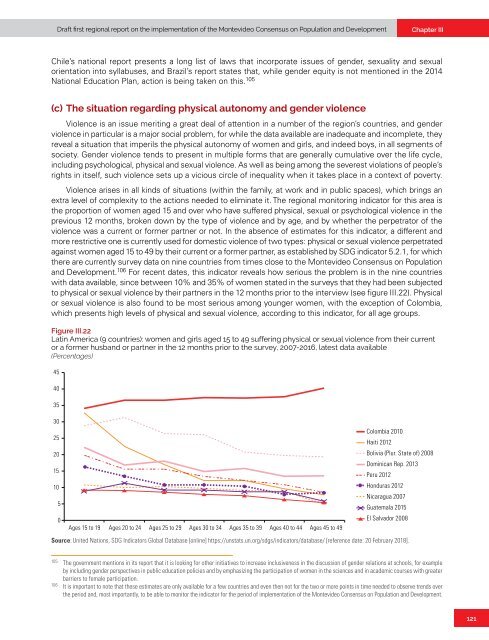Draft first regional report on the implementation of the Montevideo Consensus on Population and Development
This draft report seeks to give an account of progress in the implementation of the priority measures of the Montevideo Consensus on Population and Development in the region, as well as the differences between countries in terms of the degree of implementation. By highlighting relevant national experiences, it also seeks to facilitate the exchange of good practices among countries so that they can benefit from each other in their efforts to advance the implementation of the actions of the Montevideo Consensus.
This draft report seeks to give an account of progress in the implementation of the priority measures of the Montevideo Consensus on Population and Development in the region, as well as the differences between countries in terms of the degree of implementation. By highlighting relevant national experiences, it also seeks to facilitate the exchange of good practices among countries so that they can benefit from each other in their efforts to advance the implementation of the actions of the Montevideo Consensus.
You also want an ePaper? Increase the reach of your titles
YUMPU automatically turns print PDFs into web optimized ePapers that Google loves.
<str<strong>on</strong>g>Draft</str<strong>on</strong>g> <str<strong>on</strong>g>first</str<strong>on</strong>g> <str<strong>on</strong>g>regi<strong>on</strong>al</str<strong>on</strong>g> <str<strong>on</strong>g>report</str<strong>on</strong>g> <strong>on</strong> <strong>the</strong> implementati<strong>on</strong> <strong>of</strong> <strong>the</strong> M<strong>on</strong>tevideo C<strong>on</strong>sensus <strong>on</strong> Populati<strong>on</strong> <strong>and</strong> <strong>Development</strong><br />
Chapter III<br />
Chile’s nati<strong>on</strong>al <str<strong>on</strong>g>report</str<strong>on</strong>g> presents a l<strong>on</strong>g list <strong>of</strong> laws that incorporate issues <strong>of</strong> gender, sexuality <strong>and</strong> sexual<br />
orientati<strong>on</strong> into syllabuses, <strong>and</strong> Brazil’s <str<strong>on</strong>g>report</str<strong>on</strong>g> states that, while gender equity is not menti<strong>on</strong>ed in <strong>the</strong> 2014<br />
Nati<strong>on</strong>al Educati<strong>on</strong> Plan, acti<strong>on</strong> is being taken <strong>on</strong> this. 105<br />
(c) The situati<strong>on</strong> regarding physical aut<strong>on</strong>omy <strong>and</strong> gender violence<br />
Violence is an issue meriting a great deal <strong>of</strong> attenti<strong>on</strong> in a number <strong>of</strong> <strong>the</strong> regi<strong>on</strong>’s countries, <strong>and</strong> gender<br />
violence in particular is a major social problem, for while <strong>the</strong> data available are inadequate <strong>and</strong> incomplete, <strong>the</strong>y<br />
reveal a situati<strong>on</strong> that imperils <strong>the</strong> physical aut<strong>on</strong>omy <strong>of</strong> women <strong>and</strong> girls, <strong>and</strong> indeed boys, in all segments <strong>of</strong><br />
society. Gender violence tends to present in multiple forms that are generally cumulative over <strong>the</strong> life cycle,<br />
including psychological, physical <strong>and</strong> sexual violence. As well as being am<strong>on</strong>g <strong>the</strong> severest violati<strong>on</strong>s <strong>of</strong> people’s<br />
rights in itself, such violence sets up a vicious circle <strong>of</strong> inequality when it takes place in a c<strong>on</strong>text <strong>of</strong> poverty.<br />
Violence arises in all kinds <strong>of</strong> situati<strong>on</strong>s (within <strong>the</strong> family, at work <strong>and</strong> in public spaces), which brings an<br />
extra level <strong>of</strong> complexity to <strong>the</strong> acti<strong>on</strong>s needed to eliminate it. The <str<strong>on</strong>g>regi<strong>on</strong>al</str<strong>on</strong>g> m<strong>on</strong>itoring indicator for this area is<br />
<strong>the</strong> proporti<strong>on</strong> <strong>of</strong> women aged 15 <strong>and</strong> over who have suffered physical, sexual or psychological violence in <strong>the</strong><br />
previous 12 m<strong>on</strong>ths, broken down by <strong>the</strong> type <strong>of</strong> violence <strong>and</strong> by age, <strong>and</strong> by whe<strong>the</strong>r <strong>the</strong> perpetrator <strong>of</strong> <strong>the</strong><br />
violence was a current or former partner or not. In <strong>the</strong> absence <strong>of</strong> estimates for this indicator, a different <strong>and</strong><br />
more restrictive <strong>on</strong>e is currently used for domestic violence <strong>of</strong> two types: physical or sexual violence perpetrated<br />
against women aged 15 to 49 by <strong>the</strong>ir current or a former partner, as established by SDG indicator 5.2.1, for which<br />
<strong>the</strong>re are currently survey data <strong>on</strong> nine countries from times close to <strong>the</strong> M<strong>on</strong>tevideo C<strong>on</strong>sensus <strong>on</strong> Populati<strong>on</strong><br />
<strong>and</strong> <strong>Development</strong>. 106 For recent dates, this indicator reveals how serious <strong>the</strong> problem is in <strong>the</strong> nine countries<br />
with data available, since between 10% <strong>and</strong> 35% <strong>of</strong> women stated in <strong>the</strong> surveys that <strong>the</strong>y had been subjected<br />
to physical or sexual violence by <strong>the</strong>ir partners in <strong>the</strong> 12 m<strong>on</strong>ths prior to <strong>the</strong> interview (see figure III.22). Physical<br />
or sexual violence is also found to be most serious am<strong>on</strong>g younger women, with <strong>the</strong> excepti<strong>on</strong> <strong>of</strong> Colombia,<br />
which presents high levels <strong>of</strong> physical <strong>and</strong> sexual violence, according to this indicator, for all age groups.<br />
Figure III.22<br />
Latin America (9 countries): women <strong>and</strong> girls aged 15 to 49 suffering physical or sexual violence from <strong>the</strong>ir current<br />
or a former husb<strong>and</strong> or partner in <strong>the</strong> 12 m<strong>on</strong>ths prior to <strong>the</strong> survey, 2007-2016, latest data available<br />
(Percentages)<br />
45<br />
40<br />
35<br />
30<br />
25<br />
20<br />
15<br />
10<br />
5<br />
0<br />
Ages 15 to 19 Ages 20 to 24 Ages 25 to 29 Ages 30 to 34 Ages 35 to 39 Ages 40 to 44 Ages 45 to 49<br />
Colombia 2010<br />
Haiti 2012<br />
Bolivia (Plur. State <strong>of</strong>) 2008<br />
Dominican Rep. 2013<br />
Peru 2012<br />
H<strong>on</strong>duras 2012<br />
Nicaragua 2007<br />
Guatemala 2015<br />
El Salvador 2008<br />
Source: United Nati<strong>on</strong>s, SDG Indicators Global Database [<strong>on</strong>line] https://unstats.un.org/sdgs/indicators/database/ [reference date: 20 February 2018].<br />
105<br />
The government menti<strong>on</strong>s in its <str<strong>on</strong>g>report</str<strong>on</strong>g> that it is looking for o<strong>the</strong>r initiatives to increase inclusiveness in <strong>the</strong> discussi<strong>on</strong> <strong>of</strong> gender relati<strong>on</strong>s at schools, for example<br />
by including gender perspectives in public educati<strong>on</strong> policies <strong>and</strong> by emphasizing <strong>the</strong> participati<strong>on</strong> <strong>of</strong> women in <strong>the</strong> sciences <strong>and</strong> in academic courses with greater<br />
barriers to female participati<strong>on</strong>.<br />
106<br />
It is important to note that <strong>the</strong>se estimates are <strong>on</strong>ly available for a few countries <strong>and</strong> even <strong>the</strong>n not for <strong>the</strong> two or more points in time needed to observe trends over<br />
<strong>the</strong> period <strong>and</strong>, most importantly, to be able to m<strong>on</strong>itor <strong>the</strong> indicator for <strong>the</strong> period <strong>of</strong> implementati<strong>on</strong> <strong>of</strong> <strong>the</strong> M<strong>on</strong>tevideo C<strong>on</strong>sensus <strong>on</strong> Populati<strong>on</strong> <strong>and</strong> <strong>Development</strong>.<br />
121


















